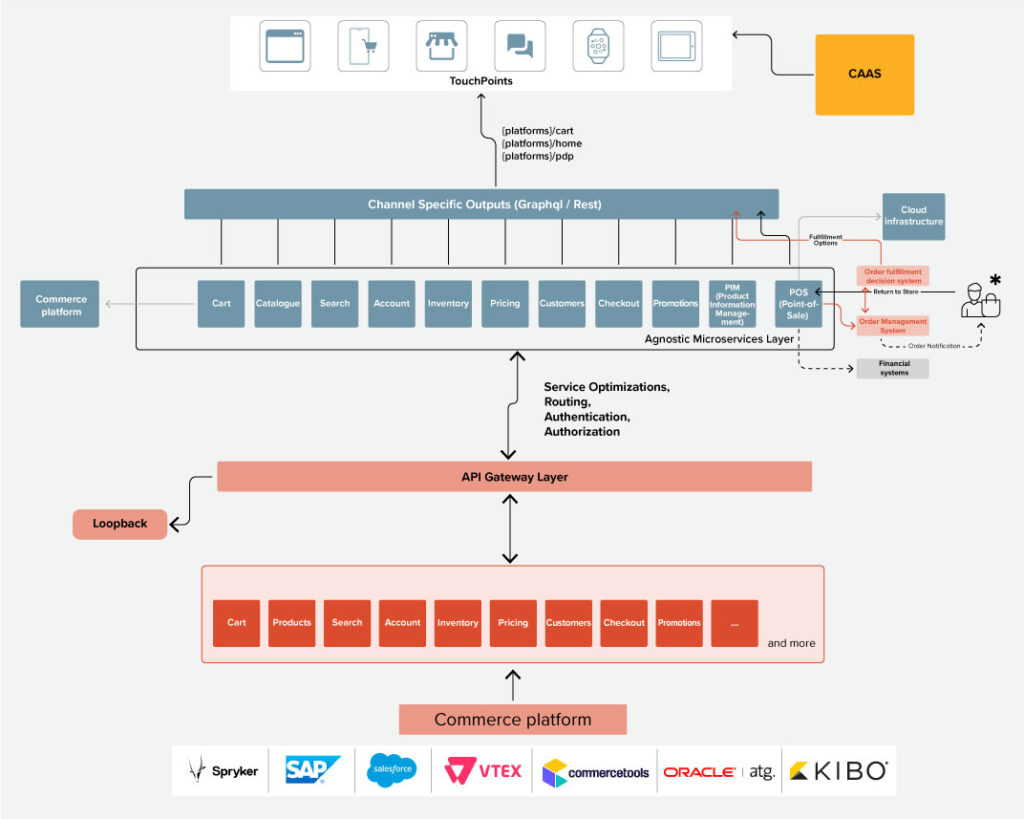
Introducing SkillNet’s Micro Frontend-based Headless Solution: Beyond Headless
Build, manage, and scale your online storefront with ultimate freedom and flexibility
SkillNet’s next-gen Beyond Headless is a platform-agnostic headless solution built on micro frontend technology that represents a paradigm shift in the approach to building and delivering web applications. It empowers enterprises to create modular, scalable, and customizable applications without being tied to a specific framework or predefined set of features.
Beyond Headless offers pre-built integrations for SAP Commerce Cloud, and compatibility with any eCommerce platform of choice, delivering ultimate flexibility and freedom to organizations to make the right technology investments for their strategic needs as they evolve.
Quick Facts: SAP Composable Storefront (Spartacus) vs Beyond Headless
| SAP Composable Storefront | SkillNet’s Beyond Headless |
|---|---|
| Compatibility is limited to SAP Commerce Cloud. | Platform agnostic, offering a future-proof, flexible alternative with no vendor lock-in. |
| Traditional Headless Architecture: Separates the frontend presentation layer (as a monolith) from the backend business logic, allowing for independent development and deployment of frontend and backend functionalities. Uses as single general-purpose API – the Commerce REST API (OCC) – to serve various UIs with different data needs. | Micro Frontend-based Headless Architecture: Goes beyond just decoupling the frontend from the backend by also breaking down the frontend application into independent, single-responsibility functionalities. Each micro frontend is developed as an independent unit with its own business logic, UI components, and APIs. Micro frontends are also deployed and scaled independently. Uses a Backend-for-Frontend (BFF) design pattern, which acts as an intermediary layer specifically designed for a particular UI. The polyglot microservices architecture enables developers to use multiple programming languages and technologies simultaneously, so individual frontend functionality can be built using whichever preferred technology is best suited for it. |
| Built with Angular and Redux. | Built with Next.js, Node.js, Typescript, and NRWL. |
| Deployed as a single app. | Deployed as micro frontends, where each micro frontend is deployed in a separate pod that can be scaled independently based on its resource needs. |
| Lacks reusability. | Each micro frontend is reusable, so its whole independent functionality can be readily reused across different parts of the application – or even across different applications. |
| Uses Solr (Search) and SmartEdit (CMS). | Enables the ability to integrate any 3rd-party Search or CMS (current pre-built integrations for leading solutions). |
| SEO optimization requires considerable effort. | SEO optimization is natively supported. |
| PWA natively supported. | PWA supported with some development effort. |
| Site analytics natively supported. | Site analytics natively supported. |
| OAuth2.0 natively supported. | OAuth2.0 supported with some development effort. |
| Multi-site support requires customization and duplicating relevant code. | Includes an app for easily changing themes. |
| Traditional SaaS business model. | The codebase is delivered upon implementation project, offering greater control and customizability, with support provided on an as-needed basis. |
The Implications for IT and Business Users
| Modular Development | Increased Scalability & Performance | ||
|---|---|---|---|
| Each micro frontend (i.e., component or feature) can be developed, deployed, and maintained independently for faster development cycles. | Teams can scale specific components horizontally and load them independently as needed. | ||
| IT Benefits | Business Value | IT Benefits | Business Value |
|
|
|
|
| Reusable Components | Greater Technology Diversity | ||
| Individual components are reusable across different parts of the same storefront, or even entirely different applications. | Developers have the freedom to use diverse technologies (e.g., React, Vue, Angular) for different micro frontends. | ||
| IT Benefits | Business Value | IT Benefits | Business Value |
|
|
|
|
Summary of Key Advantages of Micro Frontend Technology Over Traditional Headless
- Faster development, deployment, and iterative updates:
Changes to a specific micro frontend can be made and deployed independently without affecting the entire storefront, as different teams can work autonomously to implement different functions simultaneously. - Reusability:
Functionality can easily be reused in other microsites, saving the time, effort, and cost of creating it from scratch each time. Furthermore, an embedded app allows for easily changing themes to achieve a different look and feel. - Better performance:
Specific modules are loaded on demand rather than all at once, thereby reducing initial loading times.
- Improved maintainability, scalability, and resiliency:
Individual modules are easier to maintain and update because the code is smaller and less complex, and updates or bug fixes only affect the individual micro frontend. You can also scale specific features (e.g., adding more product filters) without impacting the entire platform, and if one module fails, the others will continue to function normally. - Loosely coupled teams and independent technology choices:
Different development teams can work on separate micro frontends using their preferred technologies for each specific feature without having to coordinate with other teams.
Get In Touch With Us
SkillNet Solutions, Makers of Modern Commerce, provides digital transformation consulting and technology services to companies that are looking to modernize their omnichannel touchpoints to better engage and transact with their customers.



